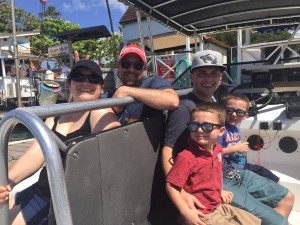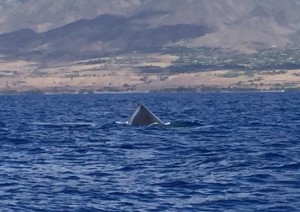
Getting ready to set sail!
My family just got back from a week-long vacation on Maui.
People keep asking me how the trip was and I never know quite how to answer…
Amazing.
Wonderful.
Perfect.
Without-a-hitch.
The problem is that I don’t really know how to put what we experienced into words. Between the beach, the pools, the views, the snorkeling, the waterfalls, the volcanoes, the surfers, the food, the sunrises, the sunsets…it was a trip like no other. A trip that I consider myself fortunate to have experienced.
One of the highlights of our trip was a “2 hour VIP Ultimate Whale Watch” excursion.
It was “VIP” because there were just 6 of us on a small boat with an experienced guide. Our guide, Tiffany, maneuvered the boat with expertise and helped us locate humpback whales off the western coast of Maui.
When we approached our first whale, she allowed my sons to lower a listening device into the water (known as a hydrophone) so that we could hear the whale “singing.” So cool! From there, we explored the waters and watched nearby whales blowing and breaching. According to my numbers-focused 6 year old, we saw 17 whales, including females, their male “escorts” and their baby calves.
Watch a [Video]:
After returning to shore, I just couldn’t get these gentle giants off my mind, so I decided to look into the science and ecology behind protecting this magnificent endangered species.
Knowing that other animals and fish are tracked using barcodes and RFID technology, I was curious to find out if this was the case for humpbacks.
Pacific Whale Foundation has an informative website for educating oneself about the humpback whales found among the Hawaiian Islands, and does, in fact, track the whales that migrate into Hawaiian waters – but not with RFID. According to the Foundation’s website, the tracking method is as follows:
“Using platforms of opportunity, trained naturalists record vessel GPS tracks using our exclusive web application, “Whale and Dolphin Tracker”. Along with a GPS location, the application allows the naturalist to record data about each sighting including pod composition and behavior.”
Here is a map, updated in real-time, of the whale and dolphin sightings off the coast of Maui for the past seven days. Also, I came across a great government website that has plenty of interesting background information about humpback whales.
The last day of our trip, my husband, sons, and in-laws were able to witness the most incredible sight of all as they walked along the beach. A mother whale breaching and giving birth to her calf! Needless to say, I am SO disappointed to have missed it. Until next time, I guess. Aloha!
I’m curious to learn more about different types of animals, endangered or not, that are tracked by RFID or other means. Please share your insights with me on Twitter @LTronCorp.
About the Author:
 Carmella Giancursio is L-Tron’s Public Relations Specialist & Content Editor. When she’s not working, spending time with her husband, or taking care of her 3 young kids, she can be found in the kitchen, channeling her Italian heritage! Email info@L-Tron.com with questions, or call us at (800) 830-9523.
Carmella Giancursio is L-Tron’s Public Relations Specialist & Content Editor. When she’s not working, spending time with her husband, or taking care of her 3 young kids, she can be found in the kitchen, channeling her Italian heritage! Email info@L-Tron.com with questions, or call us at (800) 830-9523.














